A Primer on Fighting Vehicles
The start of the 20th century still had armies mostly composed of man and horse but fighting vehicles gradually became the primary means of moving troops and supplies. From its humble beginnings during the Battle of the Somme in 1916, the tank emerged as the most representative weapon of land warfare due to its combination of firepower, protection, and speed. However, mechanized armies require a plethora of different combat vehicles to provide mobility and fire support for the infantry, reconnaissance, and other secondary roles. Artillery has also become mechanized given the obvious advantages of mobility compared to their simpler, towed counterparts.
Tanks (World War I - World War II)
Heavy Tank: The original Mark I tanks that were introduced by the British Army in 1916 were lumbering behemoths that were truly the first heavy tanks in existence: tanks that maximized their firepower and protection at the expense of speed. This philosophy was taken to their maximum expression by the Wehrmacht and Red Army during World War II which fielded superb heavy tanks like the Tiger and Panther as well as the KV and IS series (USSR). These typically had gun calibers of over 76-mm and weighed over 40 tons. The British 'infantry tank' concept (exemplified by the Churchill) was similar to the heavy tank, albeit with lighter armament designed for infantry support rather than tank-to-tank combat. The advent of more powerful engines eventually negated the speed restrictions of heavy tanks which became largely obsolete in the 1950s once Main Battle Tanks became the standard.
Light Tank: The Renault FT-17 (France) entered service in 1918 and revolutionized tank design thanks to its speed and turreted gun. Although tanks would gradually get bigger during the interwar years, even at the start of World War II most armored forces were composed primarily of light tanks like the Panzer I and II (Germany). However, the quick rise in gun calibers and armor thickness following the early Blitzkrieg campaigns left light tanks increasingly relegated to reconnaissance or other secondary duties although some countries like Italy and Japan continued to rely heavily on them throughout the conflict. A small number of light tank designs were produced during the Cold War, mostly for specialized duties like airborne operations like the M551 Sheridan (US) or amphibious assaults like the PT-76 (USSR).
Medium Tank: The medium tank emerged as the standard tank type during World War II, having an ideal mix of firepower, armor thickness, and speed. A typical World War II-era medium tank weighed around 25-30 tons and had a gun caliber of at least 50-mm, although 75/76-mm was more common by 1943-45. The two most widely produced tanks of World War II were medium tanks, these being the T-34 (USSR) and the M4 Sherman (US), the latter which became the standard tank of both the US and British armies for their liberation of Western Europe. The British 'cruiser tank' concept (exemplified by the Crusader and Cromwell) was also similar. By the end of the war, the goal of maximizing firepower and protection without sacrificing speed became technologically feasible thus rendering the medium tank obsolete.
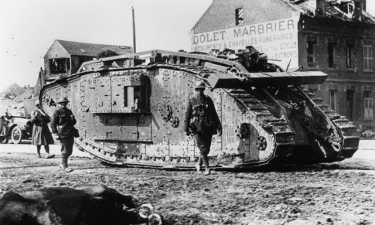 |
The slow and lumbering Mark IV tanks of World War I were not just some of the first tanks to ever be used in combat but were the quintessential heavy tanks, designed to support infantry and take as much punishment as possible. |
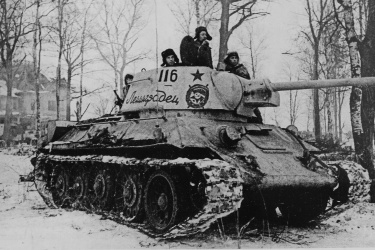 |
The Soviet T-34 had an enviable combination of speed, firepower, and mechanical simplicity, making it arguably the best medium tank of World War II. It was better than anything the Germans could put up against it 1941 and remained the mainstay of the Red Army until it rolled into Berlin. |
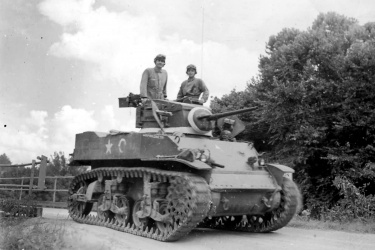 |
From the deserts of North Africa to the jungles of Burma to the hedgerows of Normandy, the Stuart light tank found itself wherever the US and British armies were to be found, where its speed and versality made up for its weaknesses in firepower and protection. |
Main Battle Tanks
Main Battle Tank: The main battle tank (MBT) has been standard tank design since the end of World War II, rendering the older medium/heavy distinctions largely irrelevant given that they combine the best attributes of both. MBTs have gone through three major generations which have incorporated design philosophies based on the technologies of their eras. Additionally, some consider some of the newest MBTs part of a fourth generation. They are described as follows:
- 1st Generation (1945): A convincing case could be made that the German Panther was the first tank that approximated the desired attributes of an MBT, although it was arguably the British Centurion (which barely missed action in World War II) that deserves the accolade of being the first true MBT. The USSR was not far behind with its T-54/55 which became the most widely produced tank in history and incredibly remains in service to this day with dozens of former Soviet client states. The US was a latecomer to MBT design with the M48, second in the Patton series of tanks that would be the mainstays of the US tank force during the Cold War. Gun calibers on 1st Generation tanks ranged from around 84-100-mm, while armor continued to be made primarily of steel plates.
- 2nd Generation (~1960): The 2nd Generation of tanks was dominated by a design philosophy debate over the need to prioritize protection or speed following the advent of advanced HEAT rounds that could penetrate most contemporary armor regardless of thickness. Some countries like the US, Britain, and the USSR opted for maximum protection in their respective M60, Chieftain, and T-64 tanks. In contrast, Germany and France opted for speed in their Leopard 1 and AMX-30 tanks. The 2nd Generation was also notable for the widespread use of the British L7 105-mm rifled gun among NATO tank forces (initially equipped on late Centurion variants), as well as composite armor designed to better protect against HEAT rounds. Soviet tanks by now were upgunned to 115-125-mm calibers and began the tradition of using autoloaders.
- 3rd Generation (~1980): The development of Chobham ceramic composite armor in the UK in the late 1970s revolutionized tank design and put protection at the forefront once again. HEAT projectiles gave way to a preference for kinetic ammunition, primarily armor-piercing fin-stabilized discarding sabot (APFSDS) rounds which are now the mainstay of most tank armies and can penetrate nearly a meter of steel armor or their composite equivalent. Chobham armor was introduced in the M1 Abrams (US) and Challenger (UK) tanks which performed admirably during the 1991 Gulf War, handily defeating their obsolete first- and second-generation Iraqi opponents. The German Leopard 2 also became a tremendous export success and its Rheinmetall Rh-120 120-mm smoothbore gun is so effective it went on to equip the M1 as well. On the other side of the Iron Curtain, Soviet/Russian tank design fell somewhat behind the West in the 1980s with the T-80 and T-90, though the latter has introduced numerous new technologies such as hard- and soft-kill defenses active protection systems (APS). Perhaps the most important development of the 3rd Generation of tanks, however, has been the entry into the market of countries that hitherto lacked a major indigenous tank tradition including Israel (Merkava), Japan (Type 90), South Korea (K1), and China (Type 99), raising to around a dozen the number of countries currently capable of designing a first-class MBT.
- 4th Generation (~2010): It is questionable whether a 4th Generation of tanks truly exists (this author sees it more as an interim 3.5 generation), although some media and enthusiast outlets have given this denomination to a small number of new tank designs that emerged in the second decade of the 21st century, namely the Type 10 (Japan), K2 Black Panther (South Korea), and the T-14 Armata (Russia). Aside from incorporating the same advanced features as the 3rd Generation, these tanks feature APS and other sophisticated electronics. The T-14 even goes as far as having an unmanned turret. New variants of 3rd Generation tanks are expected to enter service over the course of the decade, incorporating many similar technologies.
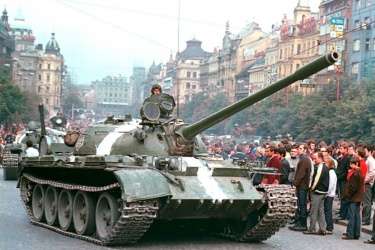 |
The T-55 is the most widely produced tank in history and a revolutionary first-generation main battle tank design that was exported to dozens of countries around the world. Even the modern T-90 shares a direct lineage to classic piece of Soviet military hardware. |
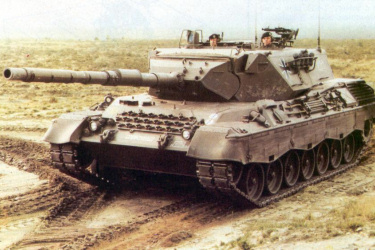 |
The Leopard 1 marked the renaissance of Germany's tank industry after its post-war stasis. Armed with the ubiquitous British L7 gun, it became the most widely used second-generation tank among NATO countries. |
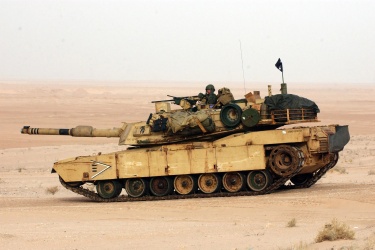 |
The M1 Abrams has been the most successful third-generation tank in combat, performing splendidly in the 1991 and 2003 wars against Iraq. A proper face off against other modern rivals, however, has yet to materialize. |
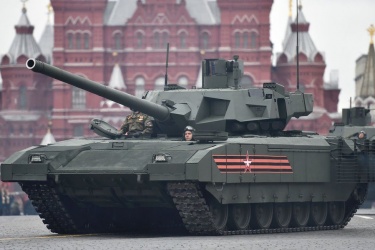 |
The T-14 Armata is first main battle tank to feature an unmanned turret as well as other recent innovations like an active protection system. But is it that revolutionary to really be considered a fourth-generation tank? |
Tank Destroyers and Assault Guns
Tank Destroyer (TD): A tank destroyer is a vehicle designed to be a tank hunter while lacking some of the characteristics of a tank in order to reduce cost. These have followed different design philosophies depending on the army employing them. Early World War II tank destroyers were essentially anti-tank guns mounted on the chassis of a light tank such as in the Panzerjäger and Marder series (Germany). Late war tank destroyers, however, were much larger and heavily armored as well as was the case with the Elephant and Jagdpanther (Germany) which had some of the thickest armor of any wartime fighting vehicle but which were simpler to produce than a tank due to their lack of turrets; their guns were installed on the chasis superstructure. Others like the SU-85/100 (USSR) sat somewhere in the middle. US tank destroyers like the M10 Wolverine and M36 Jackson followed a different philosophy than their German and Soviet counterparts, packing the same gun as found on its M4 and M26 tanks (or a 17-pdr gun in British service) in a turret, but lightly armored in order to maximize speed. Most post-war tank destroyers have been based around ATGMs, usually mounted on an existing APC chassis. However, some gun platforms have appeared in recent years, notably the B1 Centauro (Italy) and the M1128 mobile gun system version of the Stryker (US).
Assault Gun (AG): The assault gun is superficially similar to the tank destroyer (at least their German and Soviet interpretations) but serves a different purpose, namely that of infantry support. As such they usually have higher caliber guns than tank destroyers but optimized for high-explosive rather than armor-piercing rounds. In contrast to the relative sizes of their tank destroyers, German assault guns were typically smaller and less heavily protected as was the case with the StuG III, the most widely produced German armored fighting vehicle of the war and which was roughly the size and weight of a medium tank (it was based on the Panzer III chassis) but considerably cheaper. In contrast, Soviet assault guns were veritable monsters, incorporating 122-mm or even 152-mm guns in the ISU-122 and ISU-152 respectively. Despite their intended role as infantry support, guns of these calibers could destroy most tanks as well and so these vehicles are often interchangeably referred to as tank destroyers. Many have also been referred to as self-propelled guns although a key distinction is that an assault gun is intended for direct rather than indirect fire. Neither the US nor British armies developed purposely-built assault guns although some medium tanks were modified with infantry support guns such as the M4(105). The assault gun concept largely disappeared in the post-war period, aside from a few designs focused on airborne use like the M56 Scorpion (US) and ASU-85 (USSR).
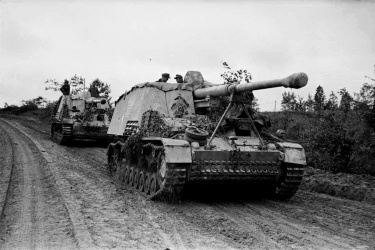 |
The Nashorn/Elefant tank destroyers were among the most powerfully armed and armored vehicles to see combat during World War II. German tank destroyer design prioritized firepower and protection, whereas US designs substituted the latter for speed. |
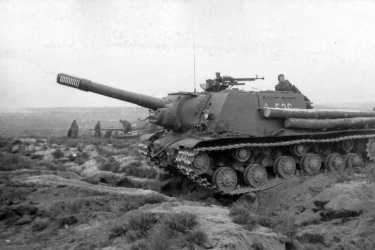 |
The Soviet ISU-152 was a monster of an assault gun, armed with a gun-howitzer that made it effective in the infantry support and anti-tank roles as could also be used for indirect fire. It's armor protection made it invaluable during urban combat, such as during the Battle of Berlin. |
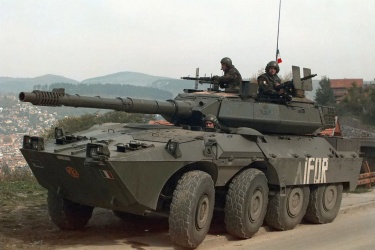 |
The Italian B1 Centauro epitomizes the modern concept of a tank destroyer: fast, light, and packing enough punch to adequately support accompanying mobile infantry should they encounter enemy armor. But it is not strictly a tank hunter like its World War II brethren. |
Armored Fighting Vehicles
Armored Personnel Carrier (APC): Armored personnel carriers (APCs) were introduced in World War II as a means to transport a squad of infantry throughout the battlefield and enable them to keep up with armored units. Widespread use of APCs along with trucks and jeeps enabled the US and British armies to be the first fully motorized armies, in contrast to the more limited use of them in the Panzer and Panzergrenadier units of the German army. APCs came in different flavors such as the fully tracked Universal Carrier (UK) or the M3 (US) and SdKfz 251 (Germany) half-tracks, and most have some limited combat capability (usually a roof-mounted machine gun) and some degree of protection against small-caliber ammunition though they are not meant for combat. Most major armies fully motorized in the 1950s and the Cold War gave some notable designs such as the US M113, the most widely built tracked APC ever built, as well as the Soviet BTR series, whose unique chassis design became the basis of nearly every wheeled APC since like the Piranha (Switzerland), LAV III (Canada) and Stryker (US). There has been a trend in the post-Cold War period towards wheeled rather than tracked APCs given their lower cost, easier maintenance, and superior road performance (albeit at the cost of inferior off-road performance). This has also resulted in a proliferation of APC designs with over two dozen countries currently producing them (and aggressively marketing them for export). APCs are also increasingly adopting a modular design, such as the German/Dutch Boxer which comes with various armor configurations and can also be converted into different roles. Army units that are based around APCs rather than soft-skinned vehicles like trucks are considered mechanized rather than motorized.
Infantry Fighting Vehicle (IFV): IFVs are similar to APCs in that they are meant to transport a squad of infantry across the battlefield. Unlike APCs, IFVs are fully combat capable and are typically equipped with a rapid-firing autocannon of at least 20-mm caliber and often, anti-tank guided missiles (ATGMs) as well. Firing ports are also provided to the troop compartment so that the infantry can fire from inside the vehicle. The USSR was the first country to adopt IFVs on a mass basis with their BMP series which entered service in the 1960s, though these were quickly followed by NATO designs such as the Marder (Germany), M2/M3 Bradley (US), and Warrior (UK). Most IFVs are tracked in order for them to have the same cross-country capabilities of tanks, but they are also found in wheeled versions such as the newer French VCMI.
Infantry Mobility Vehicle (IMV): This is a relatively new classification used on light APCs that are the modern equivalent to a scout car, serving as personnel carriers, reconnaissance, or security vehicles. Physically, they resemble militarized versions of civilian off-road vehicles, confering protection against small-caliber rounds and usually providing some firepower of their own in the form of a roof-mounted machine gun. IMVs are usually cheap and unsophisticated enough that they can be produced even by smaller armies. Examples include the Bushmaster (Austrialia), Dingo (Germany), as well as the MRAP program of mine-resistant vehicles used extensively by the US and Coalition forces in Iraq and Afghanistan.
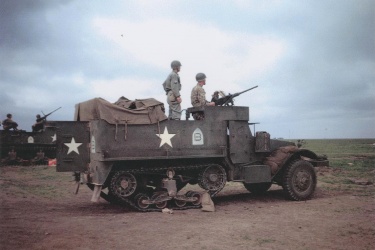 |
The US and British armies of World War II were the first fully motorized armies in history. For this US, this was in no small part thanks to the M3 half-track. Alas, half-tracks largely fell out of favor after the war in favor of fully tracked or wheeled designs. |
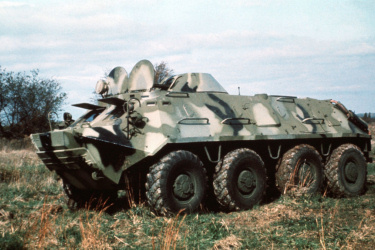 |
The Soviet BTR-60 was one of the most revolutionary combat vehicle designs of the post-war era, essentially setting the standard for nearly every armored personnel carrier that followed. Wheeled APCs like the BTR-60 now form the core of almost every army on the planet. |
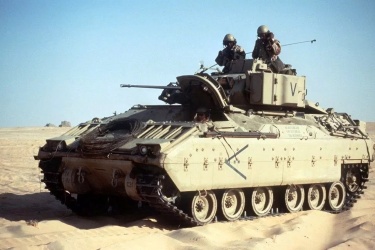 |
The US came late to the IFV race but they produced a winner in the form of the M2/M3 Bradley. Its Bushmaster autocannon is tremendously effective against most (non-tank) armored vehicles and should it encounter a tank, it has two TOW missiles at the ready. |
Reconnaissance
Armored Car (AC): The armored car was the first use of the motor vehicle in a combat role, providing a fast-moving platform for machine guns or other small-caliber weapons while offering some degree of protection for their crews. Their introduction predated World War I and by World War II were used primarily for armed reconnaissance. Armored cars were designed in various wheeled configurations and typically carried armament similar to that of light tanks although this varied considerably. For example, the Humber (UK) and M8 (US) had 37-40-mm guns whereas the Sd.KFz. 234/2 (Germany) weighed 10 tons and carried a 75-mm gun, making it heavier and more powerful than a Panzer I or II. After the war, armored cars remained attractive for countries looking for fast, powerfully-armed vehicles but which could not afford more expensive. Examples of these include the Panhard ABL (France), Saladin (UK), and the EE-9 Cascavel (Brazil), the first of which was one of the most widely used combat vehicles of the Cold War.
Scout Car (SC): Nearly identical to the armored car but less powerfully armed (typically only machine guns) or in some cases are unarmed altogether. They are used primarily for scouting and observation duties where there is no perceived need to engage with opposing combat vehicles. The Dingo (UK) and BA-64 (USSR) were typical examples during World War II, while post-war examples include the BRDM series (USSR) as well as the Ferret (UK).
Armed Reconnaissance Vehicle (ARV): The term armed reconnaissance vehicle is typically used for vehicles with similar roles as armored or scout cars but which are tracked rather than wheeled, such as the Scimitar and Scorpion (UK). In size and function, they are the post-war equivalents to World War II-era light tanks and it is not uncommon to see them referred to as such. Additionally, the term may be used for vehicles that rely more on electronic and optical sensors which allows them to maintain some distance from opposing forces. In many cases, these borrow the chassis of APCs making them larger than an armored car, typically 8x8 if wheeled as in the case of the Luchs (Germany) or the M1127 reconnaissance version of the Stryker (US). Nevertheless, there is considerable overlap between these vehicle types, which is further blurred in smaller designs like the Fennek (Germany).
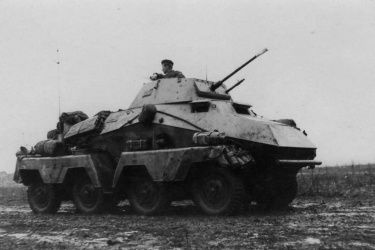 |
The Wehrmacht was a major proponent of armored cars which came in four-, six-, and eight-wheeled versions, like this SdKfz 231 (8-Rad). Aside from recon duties, they gave an extra dimension of mobility and firepower when more powerful armored vehicles like tanks were not available. |
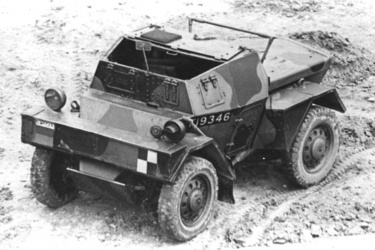 |
It may look almost toy-like by today's standards but the Daimler Dingo was one of many superlative British armored and scout car designs of World War II. Scout cars like the Dingo typically lacked armament more powerful than a machine gun as they were meant to avoid combat as much as possible. |
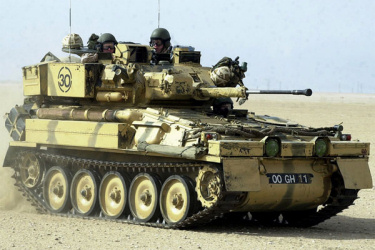 |
Armored reconnaissance vehicles have upped the ante compared to their wartime predecessors, featuring heavier armament and are also often tracked to keep up with mechanized forces. The British Scorpion is an excellent example of a modern ARV. |
Artillery
Self-Propelled Gun (SPG): A self-propelled gun is an artillery piece mounted on an vehicle chassis, thus offering it a major improvement in mobility compared to their horse- or truck-towed counterparts and eliminating the need to be unlimbered and set up in their firing positions. Although the concept was introduced in World War I, it was not until World War II when SPGs saw more widespread service although they still represented a minority of artillery on the battlefield. It was only until later in the Cold War that most major armies transitioned to SPGs as their main type of artillery, with notable examples being the 155-mm M109 (US) which saw widespread use among NATO armies as well as the 122-mm 2S1 Gzovdika and 152-mm 2S3 Akatsiya (USSR). Despite resembling tanks in size and shape, SPGs typically have very light armor and modest defensive firepower, usually no more than a machine gun. Some World War II-era Soviet assault guns, however, blurred the line with SPGs, being heavily armored and frequently employed as tank destroyers. However, a key distinction is that an SPG is primarily an indirect fire weapon operating behind the front lines whereas an assault gun is used for direct fire, hence the need for greater protection. SPGs are often differentiated as self-propelled (field) guns or self-propelled howitzers depending on the type of weapon. In practice, almost all SPGs are 'gun-howitzers' given that modern artillery can typically be used interchangeably for both the field gun (flat trajectory of fire) or howitzer (angled trajectory of fire) roles.
Multiple Rocket Launcher (MRL): Vehicle-mounted rocket launchers were introduced in World War II with the legendary Soviet 'Katyusha' family which consisted of rocket launch rails mounted on a truck. Other wartime designs included the Panzerwerfer (Germany) and the T34 Calliope (US), a conversion of the M4 tank. MRLs are not as accurate as howitzers but their ability to fire large salvos with bigger warheads means that they are able to saturate a much larger area which is particularly devastating against troops and vehicles caught in the open. Most post-war MRL platforms remained truck-mounted and relatively simple, as exemplified by the BM-21 Grad which became the mainstay of the Soviet rocket artillery force and also used (and copied) extensively abroad. MRLs gradually became more sophisticated, notably the US M270 MLRS which was widely adopted among NATO armies in the 1980s and which can even fire tactical missiles.
Mortar Carrier (MC): A similar concept to the SPG and MRL but with a mortar instead. Mortar carriers have been based on many different chassis types including half-tracks (mainly by the US in World War II), tracked vehicles, and wheeled vehicles, these being often based on an existing APC design. The USSR also introduced self-propelled gun-mortars like the 2S9 Anona which have some degree of anti-tank capability as well.
Self-Propelled Anti-Aircraft Gun (SPAAG): Like most forms of artillery, anti-aircraft guns found themselves installed on vehicle chassis beginning in World War II. These could be in the form of machine guns or cannon (often in dual- or quad-mounts) or larger flak guns. Due to Allied air superiority, Germany was a widespread user of SPAAGs which included designs like the Wirbelwind and Ostwind which were easily recognizable thanks to their multi-sided turrets. US SPAAGs were typically mounted on the chassis of M3 half-tracks while British SPAAGs were mounted on Crusader tank hulls. The effectiveness of SPAAGs increased dramatically during the Cold War thanks to the Soviet ZSU-23-4 which incorporated a search and track radar and could be linked to other radars and SAMs. A similar Western design is the German Gepard which has proven to be extremely effective against drones in Ukraine.
Self-Propelled Air Defense (SPAD): A similar concept to the SPAAG but with surface-air-missiles (SAMs) as the primary armament rather than guns. Chassis types vary considerable, and range from light trucks to the hulls of tracked APCs or IFVs. Notable SPAD platforms include the Soviet-built 2K12 (firing SA-6 missiles) which took a toll on Israeli aircraft during the 1973 Yom Kippur War while the US has relied on the M48 Chaparral (Sidewinder missile) based on the M113 chassis and, more recently, the M6 Linebacker (Stinger missile) based on the M2/M3 chassis.
Self-Propelled Anti-Aircraft Weapon (SPAAW): The logical evolution of SPAAGs is to combine anti-aircraft guns with SAMs, the latter which allow longer-range engagements. The Soviets were the pioneers of these types of weapons starting with the 2K22 Tunguska although there has yet to be a dedicated Western equivalent.
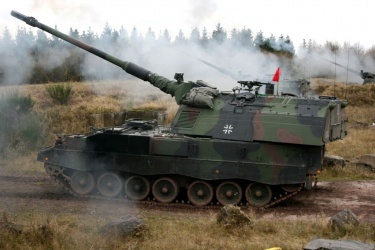 |
The German PzH 2000 is one of the most formidable artillery systems in the world and has now been adopted by numerous NATO countries. Self-propelled guns like these can keep up with mechanized forces and are also much less vulnerable to counter-battery fire thanks to their ability to 'shoot-and-scoot'. |
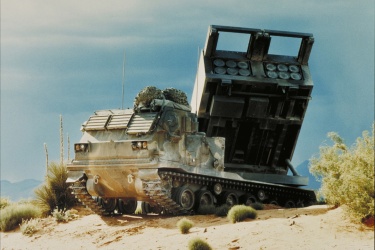 |
The M270 MLRS allowed the West to catch up with the Soviets in the application of rocket artillery. A full salvo of the M270 can cover an entire square kilometer, and the introduction of ATACMs missiles and guided rockets essentially turns it into a land-based precision weapon as evidenced by the effectivness of HIMARS strikes in Ukraine. |
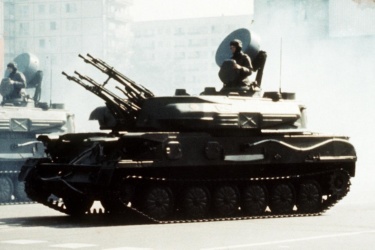 |
World War II saw the introduction of mobile anti-aircraft platforms or SPAAGs, which during the Cold War were equiped with radars and became incredibly effective against low flying aircraft as was the revolutionary Soviet ZSU-23-4. The widespread use of UAVs has given SPAAGs a new lease of life just as their effectiveness against modern aircraft had begun to wither. |
Engineering and Support vehicles
Armored Recovery Vehicle (ARV): Armored Recovery Vehicles (ARVs) are usually variants of an existing tank or APC which have been modified to carry specialized lifting and recovery equipment such as cranes, winches, and bulldozer blades as well as repair equipment. These typically replace the turret or any other main armament although some carry small defensive armament of their own. Given that they retain the protection level of their original design, they are able to operate in combat zones.
Armored Ambulance (AA): Armored Ambulances (AA) are specially modified versions of APCs where the troop compartment serves as a medical facility. These can typically carry around 3-4 stretchers or a larger number of sitting patients. Operating in combat zones, they are mostly used to carry wounded troops to dressing stations or field hospitals.
Armored Bridgelayer (ABL): As the name implies, these are specialized vehicles capable of carrying a folding metal bridge which can be laid down on a river or other obstacle. Because of the weight of the folding bridge and the need to operate close to the front lines, ABLs are usually based on a tank chassis rather than a lighter and more poorly protected APC.
Combat Engineering Vehicle (CEV): This is a generic term for a vehicle capable of undertaking engineering tasks such as mine clearing, obstacle removal, or earth moving. They also include some of the previous categories such as bridgelayers. Probably the most famous examples of these vehicles were "Hobart's Funnies" of the 79th (British) Armoured Division during World War II, which included mine-flaying Churchill and Sherman "Crabs", AVREs, DD amphibious tanks among others.
Artillery Tractor (AT): Also known as a gun tractor, these have been either trucks, half-tracks, or tracked vehicles designed to tow artillery pieces and/or their ammunition as well as transport the artillery crew. The latter generally requires a troop compartment which means that these vehicles can also be used as personnel carriers when required, as was the case with the US M2 half-track as well as the SfKdz 6-11 series of German half-tracks during World War II. Artillery tractors are also given the more generic term of Prime Movers given that they are not limited to towing artillery pieces and many also function as recovery vehicles.